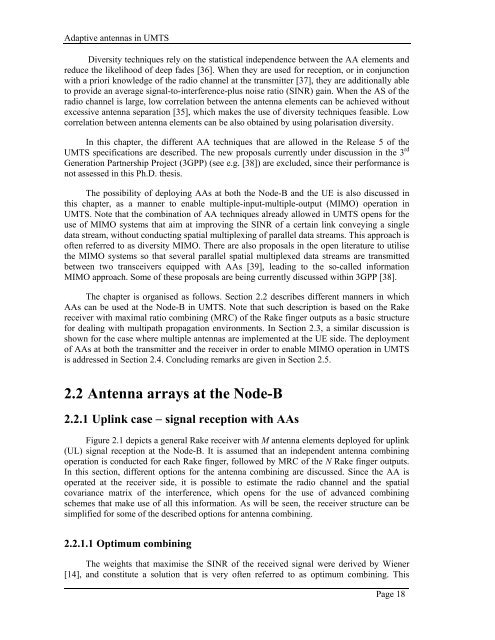System Level Performance Analysis of Advanced Antenna ... - Centers
System Level Performance Analysis of Advanced Antenna ... - Centers
System Level Performance Analysis of Advanced Antenna ... - Centers
Create successful ePaper yourself
Turn your PDF publications into a flip-book with our unique Google optimized e-Paper software.
Adaptive antennas in UMTS<br />
Diversity techniques rely on the statistical independence between the AA elements and<br />
reduce the likelihood <strong>of</strong> deep fades [36]. When they are used for reception, or in conjunction<br />
with a priori knowledge <strong>of</strong> the radio channel at the transmitter [37], they are additionally able<br />
to provide an average signal-to-interference-plus noise ratio (SINR) gain. When the AS <strong>of</strong> the<br />
radio channel is large, low correlation between the antenna elements can be achieved without<br />
excessive antenna separation [35], which makes the use <strong>of</strong> diversity techniques feasible. Low<br />
correlation between antenna elements can be also obtained by using polarisation diversity.<br />
In this chapter, the different AA techniques that are allowed in the Release 5 <strong>of</strong> the<br />
UMTS specifications are described. The new proposals currently under discussion in the 3 rd<br />
Generation Partnership Project (3GPP) (see e.g. [38]) are excluded, since their performance is<br />
not assessed in this Ph.D. thesis.<br />
The possibility <strong>of</strong> deploying AAs at both the Node-B and the UE is also discussed in<br />
this chapter, as a manner to enable multiple-input-multiple-output (MIMO) operation in<br />
UMTS. Note that the combination <strong>of</strong> AA techniques already allowed in UMTS opens for the<br />
use <strong>of</strong> MIMO systems that aim at improving the SINR <strong>of</strong> a certain link conveying a single<br />
data stream, without conducting spatial multiplexing <strong>of</strong> parallel data streams. This approach is<br />
<strong>of</strong>ten referred to as diversity MIMO. There are also proposals in the open literature to utilise<br />
the MIMO systems so that several parallel spatial multiplexed data streams are transmitted<br />
between two transceivers equipped with AAs [39], leading to the so-called information<br />
MIMO approach. Some <strong>of</strong> these proposals are being currently discussed within 3GPP [38].<br />
The chapter is organised as follows. Section 2.2 describes different manners in which<br />
AAs can be used at the Node-B in UMTS. Note that such description is based on the Rake<br />
receiver with maximal ratio combining (MRC) <strong>of</strong> the Rake finger outputs as a basic structure<br />
for dealing with multipath propagation environments. In Section 2.3, a similar discussion is<br />
shown for the case where multiple antennas are implemented at the UE side. The deployment<br />
<strong>of</strong> AAs at both the transmitter and the receiver in order to enable MIMO operation in UMTS<br />
is addressed in Section 2.4. Concluding remarks are given in Section 2.5.<br />
2.2 <strong>Antenna</strong> arrays at the Node-B<br />
2.2.1 Uplink case − signal reception with AAs<br />
Figure 2.1 depicts a general Rake receiver with M antenna elements deployed for uplink<br />
(UL) signal reception at the Node-B. It is assumed that an independent antenna combining<br />
operation is conducted for each Rake finger, followed by MRC <strong>of</strong> the N Rake finger outputs.<br />
In this section, different options for the antenna combining are discussed. Since the AA is<br />
operated at the receiver side, it is possible to estimate the radio channel and the spatial<br />
covariance matrix <strong>of</strong> the interference, which opens for the use <strong>of</strong> advanced combining<br />
schemes that make use <strong>of</strong> all this information. As will be seen, the receiver structure can be<br />
simplified for some <strong>of</strong> the described options for antenna combining.<br />
2.2.1.1 Optimum combining<br />
The weights that maximise the SINR <strong>of</strong> the received signal were derived by Wiener<br />
[14], and constitute a solution that is very <strong>of</strong>ten referred to as optimum combining. This<br />
Page 18


